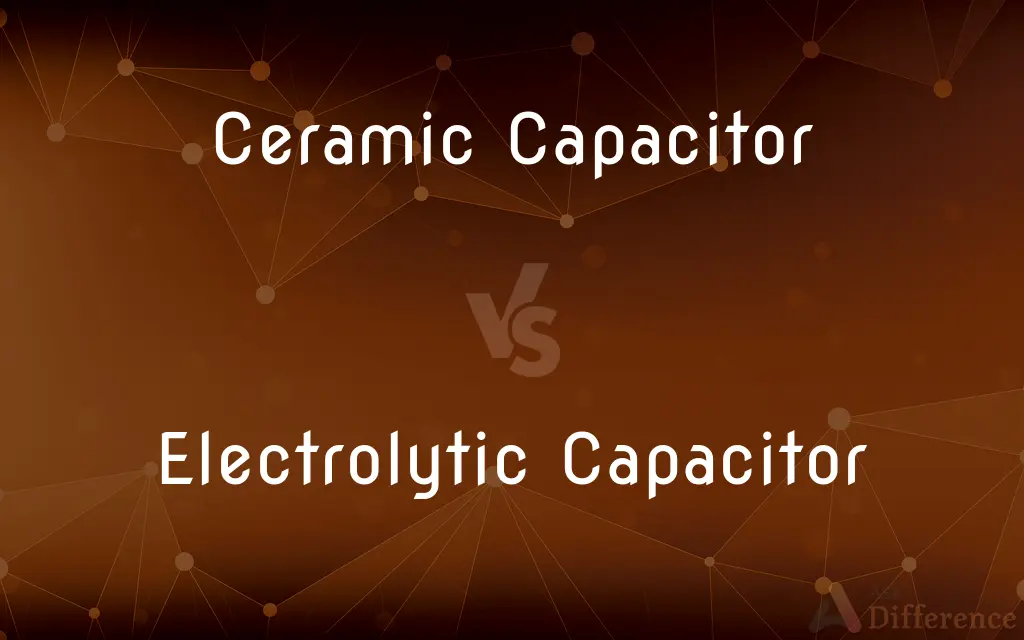Ceramic Capacitor vs. Electrolytic Capacitor — What's the Difference?
By Tayyaba Rehman — Published on January 15, 2024
Ceramic capacitors are small and non-polarized, while electrolytic capacitors are larger and polarized.

Difference Between Ceramic Capacitor and Electrolytic Capacitor
Table of Contents
ADVERTISEMENT
Key Differences
Ceramic capacitors are typically characterized by their small physical size and non-polarized nature, which allows them to be used in various electronic circuits without concern for polarity. Electrolytic capacitors, in contrast, are larger and have a polarized design, meaning they must be connected with the correct orientation to the positive and negative terminals in a circuit.
The dielectric material used in ceramic capacitors is a ceramic compound, which provides stability and high capacitance per unit volume. Electrolytic capacitors use an electrolytic paste as the dielectric, which gives them a higher capacitance but can make them less stable over time compared to their ceramic counterparts.
In terms of frequency response, ceramic capacitors generally offer excellent performance in high-frequency applications due to their small size and low equivalent series resistance (ESR). Electrolytic capacitors, due to their larger size and higher ESR, are more suited for low-frequency applications, such as power supply filtering where large capacitance values are required.
The lifespan of a ceramic capacitor tends to be longer because it does not dry out over time, unlike electrolytic capacitors, which can degrade due to the evaporation of their electrolyte, especially under high temperature or voltage conditions. This makes ceramic capacitors a more reliable choice for applications where longevity is critical.
Cost-wise, ceramic capacitors are often cheaper and are available in a wide range of values, making them a go-to choice for general use in electronic design. Electrolytic capacitors, although more expensive, are indispensable in situations that require large capacitance values, such as in smoothing ripple voltage in power supplies.
ADVERTISEMENT
Comparison Chart
Dielectric Material
Ceramic
Electrolytic solution
Temperature Stability
Stable
Sensitive
Application
High-frequency circuits
High-capacity needs
Capacitance
Lower
Higher
Lifespan
Longer
Shorter due to electrolyte loss
Compare with Definitions
Ceramic Capacitor
Capacitor with ceramic dielectric.
Ceramic capacitors are commonly used in radios.
Electrolytic Capacitor
Capacitor using electrolytic solution.
The power supply has several electrolytic capacitors.
Ceramic Capacitor
Offers stable performance across temperatures.
The ceramic capacitor maintains performance in varying temperatures.
Electrolytic Capacitor
Polarized capacitor type.
Ensure the electrolytic capacitor is correctly oriented.
Ceramic Capacitor
Non-polarized capacitor type.
The circuit uses a ceramic capacitor for stability.
Electrolytic Capacitor
Offers high capacitance values.
This circuit requires a high-capacity electrolytic capacitor.
Ceramic Capacitor
Suitable for high-frequency applications.
A ceramic capacitor filters the signal in this circuit.
Electrolytic Capacitor
Suitable for high-capacity storage.
Electrolytic capacitors are used for energy storage.
Ceramic Capacitor
Generally low in capacitance.
This device uses a small-value ceramic capacitor.
Electrolytic Capacitor
Sensitive to high temperatures.
Avoid overheating the electrolytic capacitor.
Common Curiosities
Are Electrolytic Capacitors polarized?
Yes, they are polarized.
Define Electrolytic Capacitor.
It's a capacitor that uses an electrolytic solution.
What’s the typical lifespan of a Ceramic Capacitor?
They generally have a long lifespan.
Are Ceramic Capacitors polarized?
No, they are non-polarized.
Which is more temperature stable, Ceramic or Electrolytic Capacitor?
Ceramic Capacitors are more temperature stable.
Do Electrolytic Capacitors have a long lifespan?
Their lifespan is limited due to electrolyte evaporation.
Can Electrolytic Capacitors handle high temperatures well?
No, they are sensitive to high temperatures.
Can Ceramic Capacitors store a lot of charge?
No, they generally have lower capacitance.
What is a Ceramic Capacitor?
It's a capacitor with a ceramic dielectric material.
Are Ceramic Capacitors suitable for high-frequency applications?
Yes, they are ideal for high-frequency applications.
Where are Electrolytic Capacitors typically used?
They're used in power supplies and for energy storage.
Can the polarity of Electrolytic Capacitors be reversed?
No, reversing polarity can damage them.
Which capacitor type offers higher capacitance, Ceramic or Electrolytic?
Electrolytic Capacitors offer higher capacitance.
Are Electrolytic Capacitors good for high-frequency applications?
No, they are better suited for high-capacity needs.
What are common uses of Ceramic Capacitors?
They're often used in radios and high-frequency circuits.
Share Your Discovery

Previous Comparison
Parasitism vs. Symbiosis
Next Comparison
Random Forest vs. Decision TreeAuthor Spotlight
Written by
Tayyaba RehmanTayyaba Rehman is a distinguished writer, currently serving as a primary contributor to askdifference.com. As a researcher in semantics and etymology, Tayyaba's passion for the complexity of languages and their distinctions has found a perfect home on the platform. Tayyaba delves into the intricacies of language, distinguishing between commonly confused words and phrases, thereby providing clarity for readers worldwide.
















































